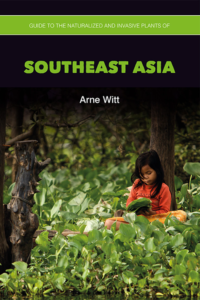Invasive alien species (IAS) are animals, plants, fungi, and microorganisms whose introduction or spread outside of their natural habitats causes economic and environmental problems. They are one of the greatest threats to biodiversity.
The proliferation of invasive alien species disrupts the ecological balance of the area being invaded. The native species lose their natural habitat and food, which can lead to their extinction. Controlling and reducing the number of these invasive alien species require financial resources that may lead to major economic problems to the areas or countries being invaded.
Various strategies and activities are being implemented to address IAS. These include collaborative engagements being organized to manage IAS in the region, such as joint workshops and conferences tackling the IAS agenda, and exchanging experiences on the management and control practices that the ASEAN Member States are doing. The SEAMEO Regional Centre for Tropical Biology (BIOTROP) regularly conducts a regional training course on IAS management to boost the knowledge and capacity of researchers, scientists and technical personnel. Research initiatives in the region and in each country focusing on specific IAS, its management and control measures have also been conducted. The UNEP-GEF-CABI Regional Project on Removing Barriers to Invasive Species Management in Production and Protection Forests in SEA is a program being implemented in Cambodia, Indonesia, the Philippines and Viet Nam, together with other stakeholders in the region including ACB.
Invasive species continue to demonstrate impacts both on land and water habitats, imposing heavy expenditures for their control and management. IAS continue to spread with the influence of changing temperatures. Although ASEAN Member Stateshave identified IAS and prioritized actions for their management, an in-depth research, survey, identification and analysis of the priority IAS in the region, including its pathways of introduction and early detection should be conducted. Cost-effective eradication and restoration programs, including research on and testing of new control technologies should be implemented. Increased efforts to manage the introduction pathways should be mainstreamed in all government and private endeavors.
Taxonomic information is essential for agencies and border authorities to detect, manage and control invasive alien species. Taxonomy is the science of naming, describing and classifying all organisms on the planet, from plants and animals to microorganisms. Following an agreed upon set of rules, scientists classify organisms using morphological, behavioral, genetic, and biochemical observations. Taxonomy provides basic understanding about the components of biodiversity, which is necessary for effective decision-making about conservation and sustainable use.
Taxonomy is becoming increasingly crucial as global biodiversity is being lost at an unprecedented rate. Habitat loss, unsustainable use of natural resources, pollution, climate change, and other drivers of biodiversity loss have combined to increase the risk of extinction of already vulnerable species. It is certain that some species are lost even before they are studied. Effective control and management measures can only be implemented when exotic species are correctly and promptly identified. Misidentifications can cost money when rapid decisions need to be taken. Networking and sharing of experiences, information and expertise can aid in lowering the costs associated with IAS and reduce the need for eradication programs with early detection and prevention. When eradication is needed, taxonomists can offer expertise that is central to developing the most effective yet economic and environmentally benign eradication measures.
Global partnerships in taxonomy
1. Global Taxonomy Initiative (GTI)
GTI was established by the CBD to address the lack of taxonomic information and expertise available in many parts of the world, and thus improve decision-making in conservation, sustainable use, and equitable sharing of the benefits derived from genetic resources. GTI highlights issues, facilitates exchange of information, and promotes technical cooperation among parties to prioritize efforts and generate greater support for taxonomy.
2.Asia Pacific Biodiversity Observation Network (AP-BON)
APBON is a regional network related to the Global Earth Observation: Biodiversity Observation Network (GEO BON), covering most countries of the Asia-Pacific region and covering all levels of biodiversity and ecosystems. AP-BON’s approaches for biodiversity observation are on three levels: remote sensing, ecological process research and species/genetic research.
3. The Global Biodiversity Information Facility (GBIF)
The GBIF is an international open data infrastructure, funded by governments, also works with organizations around the world on issues on taxonomy database and information management. GBIF allows anyone, anywhere to access data about all types of life on Earth, shared across national boundaries through the Internet. It encourages and helps institutions to publish data according to common standards, enables research, and informs better decisions to conserve and sustainably use the biological resources of the planet.
ACB activities on IAS
1. Regional Workshop on Classical Biological Control of IAS. Held in Kuala Lumpur on 24-26 September 2014, the workshop was organized by CABI in collaboration with ACB as part of a Regional Component activity in the GEF-funded FORIS project entitled Removing Barriers to IAS Management in Production and Protection Forests in SE Asia. The workshop, which had 39 participants from the ASEAN Member States, selected important regional weed species IAS for intervention with bio-control; established a Regional Working Group and its terms of reference for the selected IAS; and developed a Regional Action Plan. The IAS identified for interventions were Chromoleana odorata, Mimosa pigra, Eichhornia crassipes, and Mikania micrantha, all extremely impacting and very fast spreading invasive species in the ASEAN region.
2. ACB collects information on the occurrence and pathways of introduction of IAS. Such information is acquired from reports prepared by the ASEAN Member States, Global Invasive Species Database maintained by the Invasive Species Specialist Group and the CABI Invasive Species Compendium. ACB makes these information available through the Regional Database of Invasive Alien Species. As an early warning facility, the database on IAS provides the reference for necessary security action and raises the urgency of biodiversity conservation. Knowing IAS occurrence in a country is important in mitigating possible damage to human health and livelihood.
Nosrat Ravichandran
Programme Specialist for Conservation Policy and Research
nravichandran@aseanbiodiversity.org
Title: Guide to the Naturalized and Invasive Plants of Southeast Asia
Author: Witt, A. (CABI, Nairobi, Kenya)
Click here to download















